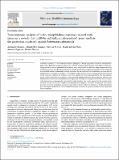Por favor, use este identificador para citar o enlazar a este item:
http://hdl.handle.net/10261/348271COMPARTIR / EXPORTAR:
 SHARE SHARE
 CORE
BASE CORE
BASE
|
|
| Visualizar otros formatos: MARC | Dublin Core | RDF | ORE | MODS | METS | DIDL | DATACITE | |

| Título: | Transcriptomic analysis of turbot (Scophthalmus maximus) treated with zymosan a reveals that lncRNAs and inflammation-related genes mediate the protection conferred against Aeromonas salmonicida |
Autor: | Romero Jódar, Alejandro CSIC ORCID; Rey-Campos, Magalí CSIC ORCID; Pereiro, Patricia CSIC ORCID; Librán-Pérez, Marta CSIC; Figueras Huerta, Antonio CSIC ORCID ; Novoa, Beatriz CSIC ORCID | Palabras clave: | β-Glucans Zymosan a Aeromonas salmonicida Immune response Cytoskeleton dynamics Apoptosis Metabolism Transcriptomics lncRNAs |
Tesauro AGROVOC: | Aeromonas salmonicida immune response apoptosis metabolism transcriptomics |
Fecha de publicación: | 2024 | Editor: | Elsevier | Citación: | Fish and Shellfish Immunology 147: 109456 (2024) | Resumen: | Aeromonas salmonicida is one of the most harmful pathogens in finfish aquaculture worldwide. Immunostimulants such as β-glucans are used to enhance the immunity of cultured fish. However, their effects on fish physiology are not completely understood. In the present work, we evaluated the effect of a single intraperitoneal (ip) injection of zymosan A on fish survival against A. salmonicida infection. A single administration of this compound protected fish against A. salmonicida challenge and reduce the bacterial load in the head kidney one week after its administration. Transcriptome analyses of head kidney samples revealed several molecular mechanisms involved in the protection conferred by zymosan A and their regulation by long noncoding RNAs. The transcriptome profile of turbot exposed only to zymosan A was practically unaltered one week after ip injection. However, the administration of this immunostimulant induced significant transcriptomic changes once the fish were in contact with the bacteria and increased the survival of the infected turbot. Our results suggest that the restraint of the infection-induced inflammatory response, the management of apoptotic cell death, cell plasticity and cellular processes involving cytoskeleton dynamics support the protective effects of zymosan A. All this information provides insights on the cellular and molecular mechanisms involved in the protective effects of this widely used immunostimulant | Descripción: | 13 pages, 7 figures, 2 tables.-- Under a Creative Commons license | Versión del editor: | https://doi.org/10.1016/j.fsi.2024.109456 | URI: | http://hdl.handle.net/10261/348271 | DOI: | 10.1016/j.fsi.2024.109456 | ISSN: | 1050-4648 |
| Aparece en las colecciones: | (IIM) Artículos |
Ficheros en este ítem:
| Fichero | Descripción | Tamaño | Formato | |
|---|---|---|---|---|
| Transcriptomic_analysis_OA_2024.pdf | 8,32 MB | Adobe PDF |  Visualizar/Abrir | |
| ScienceDirect_files_26Feb2024_09-01-04.415.zip | 838,85 kB | zip | Visualizar/Abrir |
CORE Recommender
Page view(s)
14
checked on 18-may-2024
Download(s)
10
checked on 18-may-2024
Google ScholarTM
Check
Altmetric
Altmetric
Este item está licenciado bajo una Licencia Creative Commons

